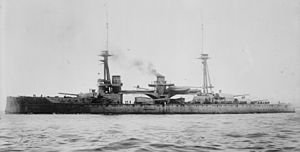Neptune-class battleship

Neptune before 1915
|
|
| Class overview | |
|---|---|
| Operators: |
|
| Preceded by: | St Vincent class |
| Succeeded by: | Colossus class |
| Completed: | 1 |
| Scrapped: | 1 |
| History | |
|
|
|
| Name: | Neptune |
| Namesake: | Neptune |
| Ordered: | 14 December 1908 |
| Builder: | HM Dockyard, Portsmouth |
| Laid down: | 19 January 1909 |
| Launched: | 30 September 1909 |
| Completed: | January 1911 |
| Commissioned: | 11 January 1911 |
| Out of service: | November 1921 |
| Fate: | Sold for scrap, September 1922 |
| General characteristics (as built) | |
| Type: | Dreadnought battleship |
| Displacement: | 19,680 long tons (20,000 t) (normal) |
| Length: | 546 ft (166.4 m) (o/a) |
| Beam: | 85 ft (25.9 m) |
| Draught: | 28 ft 6 in (8.7 m) |
| Installed power: |
|
| Propulsion: | 4 × shafts; 2 × steam turbine sets |
| Speed: | 21 knots (39 km/h; 24 mph) |
| Range: | 6,330 nmi (11,720 km; 7,280 mi) at 10 knots (19 km/h; 12 mph) |
| Complement: | 756–813 (1914) |
| Armament: |
|
| Armour: | |
HMS Neptune was a dreadnought battleship built for the Royal Navy in the first decade of the 20th century, the sole ship of her class. She was the first British battleship to be built with superfiring guns. Shortly after her completion in 1911, she carried out trials of an experimental fire-control director and then became the flagship of the Home Fleet. Neptune became a private ship in early 1914 and was assigned to the 1st Battle Squadron.
The ship became part of the Grand Fleet when it was formed shortly after the beginning of the First World War in August 1914. Aside from participating in the Battle of Jutland in May 1916, and the inconclusive Action of 19 August several months later, her service during the war generally consisted of routine patrols and training in the North Sea. Neptune was deemed obsolete after the war and was reduced to reserve before being sold for scrap in 1922 and subsequently broken up.
The launch of Dreadnought in 1906 precipitated a naval arms race when Germany accelerated its naval construction plans in response. Despite this sudden expansion of another nation's fleet, the British Admiralty felt secure in the knowledge that Germany would only have four modern capital ships in commission by 1910, while the Royal Navy would have eleven. Accordingly they only proposed the construction of a single battleship and a battlecruiser in the 1908–1909 naval budget that they sent to the government in December. The Liberals, committed to reducing military expenditures and increasing social welfare spending, wished to cut the budget by £1,340,000 below the previous year's budget, but were ultimately persuaded not to do so after the Prime Minister, Sir Henry Campbell-Bannerman, was thoroughly briefed on each part of the budget in February 1908. The debates over the budget in March were heated; critics were dissatisfied with the number of ships being built, arguing that the Government was too complacent about the superiority of the Royal Navy over the Imperial German Navy, but they were satisfied when H. H. Asquith, Chancellor of the Exchequer, filling in for the fatally-ill Prime Minister, announced that the government was prepared to build as many dreadnoughts as required to negate any possible German superiority as of the end of 1911.
...
Wikipedia
